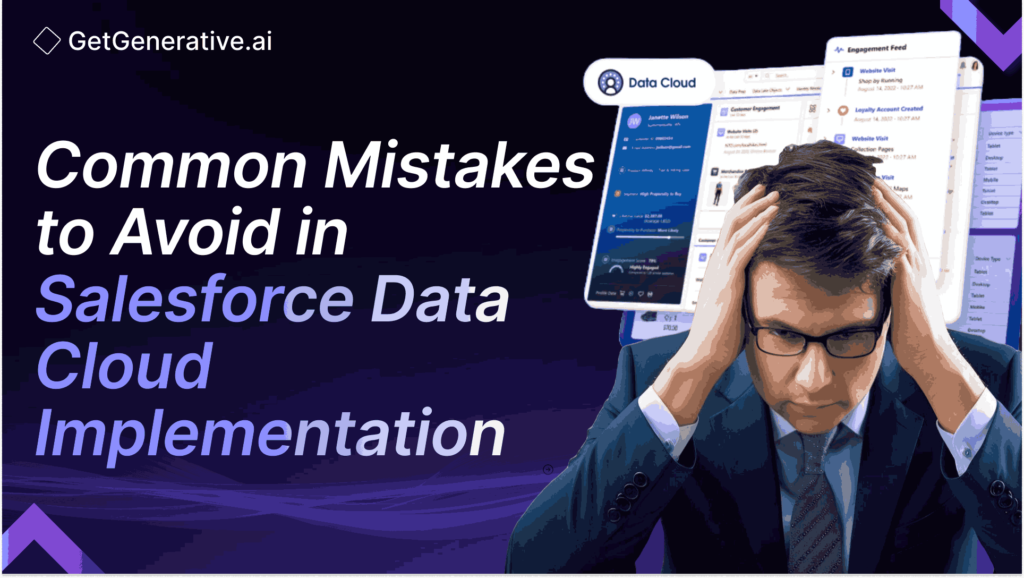Common Mistakes to Avoid in Salesforce Data Cloud Implementation
Implementing Salesforce Data Cloud can transform your organization, offering powerful tools to centralize, analyze, and act on customer data. However, a successful implementation is not just about the technology—it’s about avoiding common pitfalls that can derail your efforts. From poor planning to neglecting user training, these mistakes can cost time, resources, and business growth.
Let’s dive into the most common errors and how to avoid them.
Common Mistakes in Salesforce Data Cloud Implementation
1. Lack of Clear Objectives
Jumping into implementation without clearly defined objectives is one of the most common mistakes. A lack of direction often leads to misaligned efforts, wasted time, and unnecessary resource expenditure.
How to Avoid It:
Establish clear, measurable goals that are in sync with your business strategy. Whether you aim to refine data accuracy, enhance sales processes, or improve customer targeting, having well-defined objectives will provide a roadmap for a successful implementation.
2. Poor Data Management Practices
Bad data equals bad decisions. Poor-quality or inconsistent data can result in misleading insights and lost opportunities for growth.
How to Avoid It:
Start with data cleansing and validation to ensure accuracy and completeness. Regular audits and the use of Salesforce’s built-in data management tools can help maintain data integrity.
3. Ignoring Integration Needs
Failing to integrate Salesforce Data Cloud with existing systems creates silos, hindering the seamless flow of information.
How to Avoid It:
Prioritize integration planning from the start. Leverage Salesforce’s APIs and integration capabilities to connect key systems like ERP, marketing tools, or third-party applications. This will create a unified ecosystem where data flows seamlessly and efficiently.
4. Over-Customization
Over-customizing the platform can lead to maintenance nightmares and increased costs. While it may seem tempting to tailor everything to your liking, it often backfires.
How to Avoid It:
Customize only when necessary, ensuring changes are well-documented for future scalability.
5. Insufficient User Training
A sophisticated system is of little value if users lack the knowledge to fully utilize its features.
How to Avoid It:
Develop tailored training programs that address the unique needs of your team. Provide ongoing support and regular updates to ensure users feel confident and capable when using the platform.
6. Overlooking Security Measures
Since customer data is at the heart of operations, failing to secure it can lead to significant risks and consequences.
How to Avoid It:
Adopt robust security practices such as encryption and multi-factor authentication to protect sensitive information. Regularly review access permissions and stay compliant with data privacy regulations like GDPR or CCPA.
7. Underestimating Time and Resources
A common oversight is underestimating the scope and complexity of Salesforce Data Cloud implementation, which often results in project delays and budget overruns.
How to Avoid It:
Develop a realistic timeline and allocate sufficient resources. Include contingency buffers to account for unexpected challenges.
8. Failing to Plan for Scalability
If you don’t account for growth, your system may outgrow its initial setup, causing operational bottlenecks.
How to Avoid It:
Design your implementation with scalability in mind. Choose flexible solutions that can adapt to your evolving business needs.
Also Read – Salesforce Data Cloud Features: Optimize Your Marketing Strategy
Best Practices for a Successful Salesforce Data Cloud Implementation
1. Start with Clear Use Cases
Begin by selecting one or two high-impact use cases that directly align with your organization’s strategic objectives. For instance, streamlining customer segmentation or improving forecasting can showcase the platform’s value early on.
2. Leverage Out-of-the-Box Data Models
Salesforce Data Cloud provides pre-built data models to simplify implementation. These models save time while ensuring standardization.
Pro Tip: Align these models with Salesforce’s core data structures for seamless integration across platforms.
3. Be Intentional with Your Data
Not all data is created equal. Ensure you’re collecting the right information and using it effectively.
Key Steps:
- Implement data cleansing processes.
- Establish a data governance framework.
- Use AI tools like Salesforce Einstein to extract actionable insights.
4. Measure Success Effectively
Define clear key performance indicators (KPIs) to monitor success. Metrics such as improved revenue, higher customer satisfaction, or operational efficiency should be specific, measurable, and aligned with your goals.
Bonus Tip: Establish baseline metrics before implementation to track improvements accurately.
5. Foster Organizational Alignment
Ensuring that all stakeholders and teams are aligned is critical for a smooth implementation process.
How to Do It:
- Host cross-functional workshops to discuss implementation goals.
- Clearly define roles and responsibilities.
- Communicate the benefits of Data Cloud to gain buy-in.
Also Read – Data Cloud Glossary of Terms: An Ultimate Guide 2024
Conclusion
Salesforce Data Cloud’s success lies in the execution. Avoid common pitfalls like poor planning, data mismanagement, and insufficient training. Instead, focus on clear objectives, robust security, and intentional data use. By adhering to these proven strategies, your organization can maximize the benefits of Salesforce Data Cloud.
To learn more, visit GetGenerative.ai today!
FAQs
1. What is the main challenge in Salesforce Data Cloud implementation?
The most common challenge is the lack of clear objectives. Without defined goals, it’s difficult to align teams and measure success.
2. How can I improve data quality before implementation?
Start with data cleansing, validation, and audits. Use Salesforce’s built-in data management tools to maintain data consistency and accuracy throughout the implementation process.
3. Why is user training critical for Data Cloud?
Empowering your team with proper training enhances their ability to use the platform effectively, increasing adoption rates and productivity.
4. Can Salesforce Data Cloud scale with my business?
Yes! Salesforce Data Cloud is designed for scalability, provided you plan for growth during implementation.
5. How to Measure the Success of Your Data Cloud Implementation?
Define KPIs aligned with your goals, establish baseline metrics, and track progress over time using data-driven insights.




